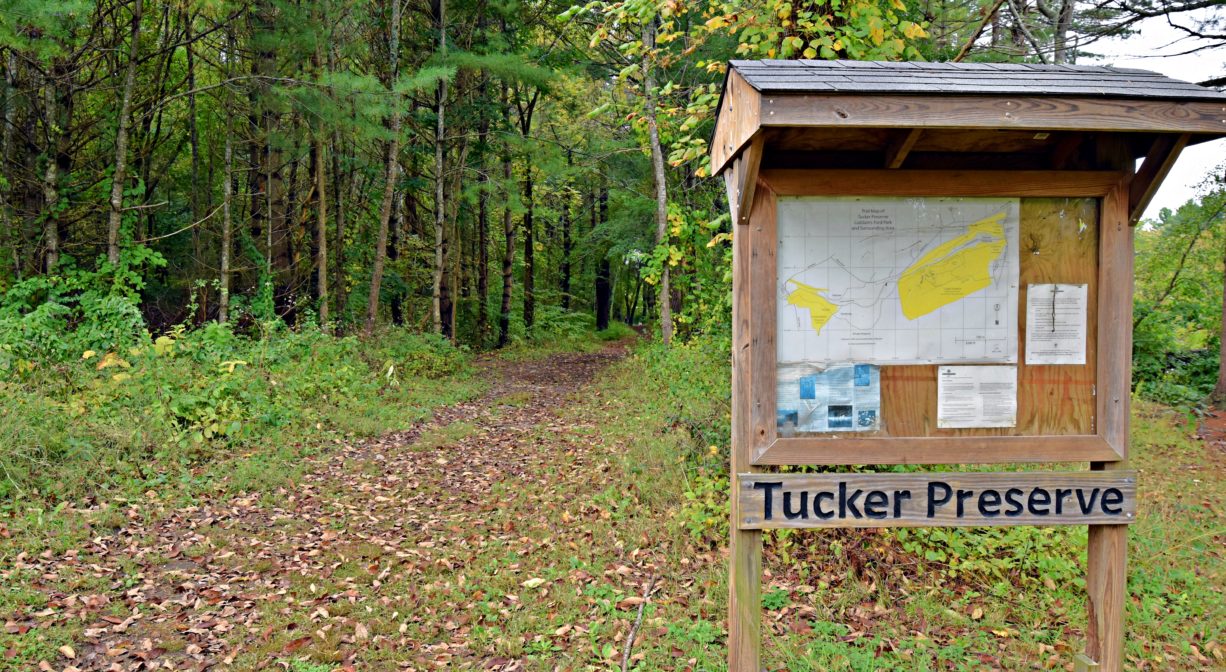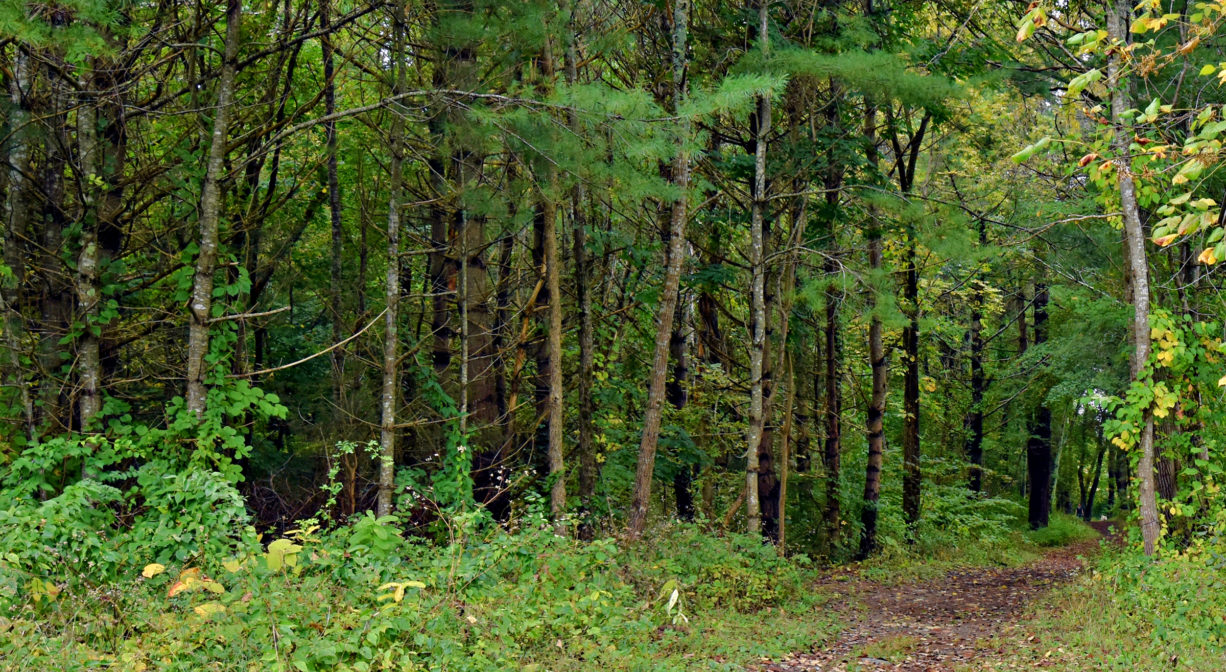400 Elm St, Pembroke, MA 02359, USA
https://wildlandstrust.org/tucker-preserve
Owned By: Wildlands Trust
Pembroke’s Tucker Preserve is 78.6 acre property owned by the Wildlands Trust. A looping network of trails leads through the woods and across two streams, with several captivating views of the Indian Head River. At the western boundary, there is a large grove of hemlock. Be sure to peer down from the top of the ridge into the river gorge: it’s an enchanting spot! Look for the remains of an old factory dam at the water’s edge. Contiguous with Ludden’s Ford Park – Pembroke and Rocky Run Conservation Area in Hanson.
For up-to-date information and real time trail conditions, visit wildlandstrust.org/trails
Features
This property was donated to the Wildlands Trust in 1993 by Sidney and Harold M. Tucker. Because of the damp darkness of the hemlock forest, and the depth of the river valley, the Tucker Preserve is often compared to Western Massachusetts or New Hampshire. Stone walls reveal the property’s agricultural past.
At the ridge along the property’s western boundary you can view the remains of the Waterman Tack Factory in Hanover. Remnants of its dam are visible on both sides of the river. It’s hard to imagine, because now it’s tucked deep into the woods, but beginning in the 1700s, this site was home to a number of industries. The earliest was probably a carding mill, where wool fibers were prepared for spinning. Other incarnations included Joseph Smith’s c. 1726 fulling mill (where wool fiber was cleaned and thickened), and later a grist mill.
In 1830, a tack factory moved in, operated by Elihu Hobart and Charles Dyer. Hobart passed away and Dyer established a partnership with E.Y. Perry, who took ownership of the factory in 1850. By 1870, the factory passed to George Curtis, who then transferred the property to Lemuel C. Waterman, Rodolphus C. Waterman and George P. Clapp, who operated the R. C. Waterman Tack Factory.
Tack is another word for nail. Waterman tacks were used primarily in shoemaking and repair, but also in the furniture and upholstery trades, for equestrian equipment, and for laying carpet. Historians indicate that many shoe repair shops, even in New York and Philadelphia, would only use Waterman tacks. The business continued to expand and thrive, and by 1875 it employed 25 people and produced 250 tons of tacks per year.
Scan the course of the river, and consider how the power of the water behind the dam was harnessed to fuel the factory. You can probably guess where the water went in, and where it went out. But now, 150 years later, where has it all gone?
In February 1886 there was an unusually heavy rain. The water rose at such speed, and to such height, that it severely damaged not only the factory but the adjacent train tracks. Subsequent storms in 1938 and 1954 did permanent damage to industries throughout the river valley. Since then, this spot has become a different world. It’s so quiet now – and so natural — it’s hard to imagine it was ever any other way.
The section of the river where the Waterman Tack Factory was located was known in the early 18th century as “Project Dale.” The name reflected both the setting (“dale” is another word for “valley”) and the varied industrial history of the area (the various “projects” undertaken here, as mentioned above).
This land is within the region of the Massachusett (or Massachuseuk) Native American tribe. The Mattakeeset band of the Massachusett lived for thousands of years in the North River watershed. Their village included most of today’s Pembroke and Hanson. To learn more about local Native American tribes, we encourage you to interact with their members. The Massachusett tribe at Ponkapoag and the Mattakeeset band of the Massachusett share information on their websites.
Trail Description
Enter the Tucker Preserve through the Pembroke side of Ludden’s Ford Park, near the fish ladder. Follow the path along the water’s edge. Soon a wooden bridge leads you across a brook, and then the trail begins a moderate incline. There is a wider, flatter option to the left, but the narrow trail to the right offers the best views.
This is the Indian Head River, appearing more like a pond here because of the dam downstream. The trail continues through the woods to a second stream crossing, and this time you’ll have to make your way across flat rocks to reach the other side. Some days, it’s easy. Other days, when more water is flowing, the crossing requires precise footwork.
At this point you will have entered a hemlock grove. If you look toward the river, you’ll find that you’ve climbed to the top of a ridge. Very likely you’ll spy a building in the distance. Continue along the trail, deeper into the woods. As the trail veers closer to the edge of the ridge, look down again. The valley is much narrower here, and incredibly picturesque. You are now at a spot called Project Dale. The building across the river was once the Waterman Tack Factory.
The trail continues a short distance from the factory overlook and soon reaches the Tucker Preserve’s western boundary. Turn back here, and retrace your route until you reach the brook you crossed on foot. This time, proceed to your right and follow a loop trail through the southern half of the 78-acre property. (We recommend carrying a map). This will eventually bring you back to the wooden bridge and Ludden’s Ford. An alternative — instead of turning back — would be to continue on the trail through Hanson’s Rocky Run Conservation Area.
As you approach the end of the trail close to Ludden’s Ford Park in Pembroke, you may notice brightly-graffiti’d ruins in the woods off to your right. These are remains of the E. H. Clapp Rubber Works, which stood on both sides of the river at the turn of the 20th century.
Habitats and Wildlife
The forests of the Tucker Preserve contain hickory, ash, elm, and other hardwoods such as red oak and black birch. Some of the trees are quite old! As the trail moves away from the river, it leads along the top of a ridge, into a dense grove of hemlock. The north-facing slope, leading down to the river, is cool and steep. At the water’s edge, look for the shells of fresh water mussels, very likely harvested by small mammals. Elsewhere on the property, there are several streams and rivulets. Look for wild geranium, jack-in-the-pulpit, lady slippers, cardinal flowers and rattlesnake plantain. Listen for deep-woods birds such as cuckoo, veery, scarlet tanager, wood thrush, and ovenbird. On sunny days, you may see turtles basking on logs or large rocks at the water’s edge.
This property is located on the Indian Head River. The Indian Head River rises from the Drinkwater River and Factory Pond in West Hanover. It forms the boundary between Hanover and Hanson, and merges with Pembroke’s Herring Brook, a short distance downstream of Ludden’s Ford Park, to form the North River at a spot called The Crotch. The North River flows 12 miles through Pembroke, Hanover, Norwell, Marshfield and Scituate, eventually making its way to Massachusetts Bay and the Atlantic Ocean.
A THREATENED FOUNDATION SPECIES: Within the Tucker Preserve, there are a number of Eastern Hemlock trees, a threatened foundation species. The Eastern Hemlock can be found throughout the eastern United States, from Georgia to Nova Scotia, and west to Minnesota. It is now seriously threatened by the hemlock wooly adelgid (HWA), a nearly microscopic aphid-like insect that attacks the hemlock’s needles. The HWA begins its infestation on the lowermost branches and climbs to the crown of the hemlock over several years, stripping the tree of its needles., buds, and eventually, branches. Most hemlocks succumb to infestation within 5-10 years.
The hemlock wooly adelgid came to the US from Asia in the 1950’s, first arriving in Virginia. The sap-sucking insect then spread north over decades and has infected 90% of the eastern hemlock’s range. Eggs and nymphs can travel from location to location via birds and other wildlife, wind, humans, and the transportation of infected wood. The HWA deposits woolly egg sacs on hemlock needles. A sign of infestation, these sacs can be spotted from February through May. To identify hemlocks on your walk, look fora coniferous evergreen with dark brown scaly bark, flat green needles and small half-inch cones.
LIFE AMONG LICHEN: Look for lichen on the rocks and stone walls of the Tucker Preserve. Lichen is a pioneer species, and among the first to colonize a new environment in a process called “primary succession.” During primary succession, generations of pioneer species decay, enriching the soil and allowing more substantial and energy intensive plants to move in.
Lichen is a result of a symbiotic relationship between algae and fungi. Algae can photosynthesize and produce its own food, while fungi cannot. But fungi can break down organic matter and increase available nutrients in the soil. Algae and fungi work together to sustain their mutual existence; they flourish in nearly every ecosystem. In lichen, the algae produce sugars through photosynthesis, from which the fungi feed. In return, the fungi shelter the algae and prevent it from drying out, allowing the organism to live for hundreds, if not thousands, of years.
Lichen, like other photosynthesizing organisms, sequesters carbon and mitigates greenhouse gas emissions. It is, however, particularly sensitive to air pollution and in some cases, may die off or be replaced by a more pollution-tolerant species. Upon this discovery in the 1970s, the US Forest Service began using lichen to monitor air quality and pollution levels. Some types of lichen commonly found along the Indian Head River Trails include: Hypotrachyna sinus, Xanthoria polycarpa, and Chaenotheca furfuracea.
FREE-FLOWING RIVERS are unaltered by human impact, and flow unobstructed, carrying and depositing nutrients and sediments along their corridors. They house essential native breeding grounds for migratory fish and provided for a biodiverse ecosystem. Prior to industrialized society, all rivers were free flowing, however, free-flowing rivers are now globally threatened, primarily by infrastructure.The section of the Indian Head River (IHR) immediately downstream of the Waterman Tack Factory site flows freely. Native fish in the IHR that need free-flowing rivers to complete their life cycle include brook trout, brown trout, rainbow trout and northern redbelly dace.
There are two dams leftover from the industrial use of the river along the Indian Head River — the highly visible one at Ludden’s Ford, and the rock remnants of one just downstream of the State Street and Cross Street bridge in Hanson and Hanover. The dam at Ludden’s Ford Park is an obstruction for the thousands of river herring and shad that come each spring to spawn in the Indian Head River. There is a fish ladder on the dam, but it is difficult if not impossible to maintain, as it is in the middle of the spillway and it is likely impassable under certain conditions. The river is host to river herring, shad, eels, freshwater mussels, and native and stocked brown and Eastern brook trout.
Historic Site: No
Park: No
Beach: No
Boat Launch: No
Lifeguards: No
Size: 78 acres
Hours: Dawn to Dusk
Parking: Limited parking at Ludden's Ford Park in Pembroke. Pedestrian access via Old West Elm Street.
Cost: Free
Trail Difficulty: Easy, Medium
Facilities:
Interpretive signage, benches. Geocache location.
Dogs: Dogs must remain on leash. Please clean up after your pet!
Boat Ramp: No
ADA Access: No
Scenic Views: Yes
Waterbody/Watershed: Indian Head River (North River watershed)












